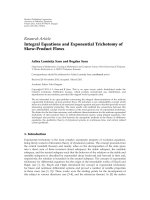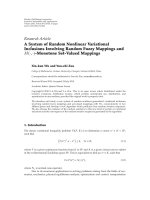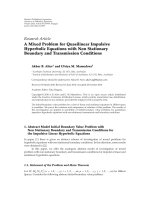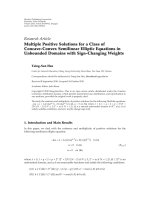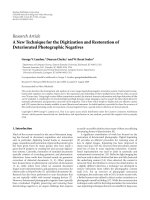Báo cáo hóa học: " Research Article Wiener-Hopf Equations Technique for General Variational Inequalities Involving Relaxed Monotone Mappings and Nonexpansive Mappings" docx
Bạn đang xem bản rút gọn của tài liệu. Xem và tải ngay bản đầy đủ của tài liệu tại đây (504.27 KB, 10 trang )
Hindawi Publishing Corporation
Journal of Inequalities and Applications
Volume 2007, Article ID 64947, 10 pages
doi:10.1155/2007/64947
Research Article
Wiener-Hopf Equations Technique for General
Variational Inequalities Involving Relaxed Monotone Mappings
and Nonexpansive Mappings
Yongfu Su, Meijuan Shang, and Xiaolong Qin
Received 1 July 2007; Accepted 3 October 2007
Recommended by Simeon Reich
We show that the general variational inequalities are equivalent to the general Wiener-
Hopf equations and use this alterative equivalence to suggest and analyze a new iterative
method for finding the common element of the set of fixed points of a nonexpansive
mapping and the set of solutions of the general variational inequality involving multival-
ued relaxed monotone operators. Our results improve and extend recent ones announced
by many others.
Copyright © 2007 Yongfu Su et al. This is an open access article distributed under the
Creative Commons Attribution License, which permits unrestricted use, distribution,
and reproduction in any medium, provided the original work is properly cited.
1. Introduction
Variational inequalities introduced by Stampacchia [1] in the early sixties have witnessed
explosive growth in theoretical advances, algorithmic development, and applications ac-
ross all disciplines of pure and applied sciences (see [1, 2] and the references therein).
It combines novel theoretical and algorithmic advances with new domain of applica-
tions. Analysis of these problems requires a blend of techniques from convex analysis,
functional analysis, and numerical analysis. In recent years, variational inequality theory
has been extended and generalized in several directions, using new and powerful meth-
ods, to study a w ide class of unrelated problems in a unified and general framework. In
1988, Noor [3] introduced and studied a new class of variational inequalities involving
two oper ators, which is known as general variational inequality. We remark that the gen-
eral variational inequalities are also called Noor variational inequalities. It turned out
that oddorder, nonsymmetric obstacle, free, unilateral, nonlinear equilibrium, and mov-
ing boundary problems arising in various branches of pure and applied sciences can be
studied via Noor variational inequalities (see [3–5]). On the other hand, in 1997, Verma
considered the solvability of a new class of variational inequalities involving multivalued
2 Journal of Inequalities and Applications
relaxed monotone operators (see [6]). Relaxed monotone operators have applications
to constrained hemivariational inequalities. Since in the study of constrained problems
in reflexive Banach spaces E the set of all admissible elements is nonconvex but star-
shaped, corresponding variational formulations are no longer variational inequalities.
Using hemivariational inequalities, one can prove the existence of solutions to the fol-
lowing type of nonconvex constrained problems (P): find u in C such that
Au −g,v≥0, ∀v∈ T
C
(u), (1.1)
where the admissible set C
⊂ E is a star-shaped set with respect to a certain ball B
E
(u
0
,ρ),
and T
C
(u) denotes Clarke’s tangent cone of C at u in C. It is e asily seen that when C is
convex, (1.1) reduces to the variational inequality of finding u in C such that
Au −g,v − u≥0, ∀v ∈ C. (1.2)
Example 1.1 [7]. Let A : E
→E
∗
be a maximal monotone operator from a reflexive Ba-
nach space E into E
∗
with strong monotonicity and let C ⊂ E be star-shaped with respect
to a ball B
E
(u
0
,ρ). Suppose that Au
0
− g=0 and that distance function d
C
satisfies the
condition of relaxed monotonicity
u
∗
− v
∗
,u − v
≥−
cu − v
2
, ∀u,v ∈ E, (1.3)
and for any u
∗
∈ ∂d
C
(u)andv
∗
∈ ∂d
C
(v)withc satisfying 0 <c<4a
2
ρ/Au
0
− g
2
,where
a is the constant for strong monotonicity of A.Here,∂d
C
is a relaxed monotone operator.
Then, the problem (P) has at least one solution.
As a result of interaction between different branches of mathematical and engineer-
ing sciences, we now have a variety of techniques to suggest and analyze various numer-
ical methods including projection technique and its variant forms, auxiliary principle
and Wiener-Hopf equations for solving variational inequalities and related optimization
problems. In this paper, using essentially the projection technique, we show that the gen-
eral variational inequalities are equivalent to the general Wiener-Hopf equations, whose
origin can be traced back to Shi [8]. It has been shown [4, 8–10] that the Wiener-Hopf
equations are more flexible and general than the projection methods. Noor [4, 9] has used
the Wiener-Hopf equations technique to study the sensitivity analysis and the dynamical
systems as well as to suggest and analyze several iterative methods for solving variational
inequalities.
Related to the variational inequalities, we have the problem of finding the fixed points
of the nonexpansive mappings, which is the subject of current interest in functional anal-
ysis. It is natural to consider a unified approach to these two different problems.
Motivated and inspired by the research going on in this direction, we first introduce
a new class of the general Wiener-Hopf equations involving. Using the projection tech-
nique, we show that the general Wiener-Hopf equations are equivalent to the general
variational inequalities. We use this alterative equivalence from the numerical and ap-
proximation viewpoints to suggest and analyze an new iterative scheme for finding the
common element of the set of fixed points of nonexpansive mappings and the set of so-
lutions of the general variational inequalities.
Yongfu Su et al. 3
2. Preliminaries
Let K be a nonempty closed convex subset of a real Hilbert space H, whose inner product
and norm are denoted by
·,· and ·, respectively. Let T,g : H→H be two nonlinear
operators, A : H
→2
H
a multivalued relaxed monotone operator, and S
1
, S
2
two nonex-
pansive self-mappings of K.LetP
K
be the projection of H into the convex set K.
We now consider the problem of finding u
∈ H : g(u) ∈ K such that
Tu+w,g(v) − g(u)
≥
0, ∀v ∈ H : g(v) ∈ K, w ∈ Au. (2.1)
Note what follows.
(1) If g
≡ I, the identity operator, then problem (2.1)isequivalenttofindingu ∈ K
such that
Tu+w,v − u
≥
0, ∀v ∈ K, w ∈ Au, (2.2)
which is considered as the Verma general variational inequality introduced and
studied by Verma [6] in 1997. Next, we will denote the set of solutions of the
general variational inequality (2.2)byGVI(K,T,A).
(2) If w
≡ 0, then problem (2.1) reduces to finding u ∈ H : g(u) ∈ K such that
Tu,g(v) − g(u)
≥
0, ∀v ∈ H : g(v) ∈ K, (2.3)
which is known as the general variational inequality introduced and studied by
Noor [3] in 1988.
(3) If w
≡ 0andg ≡ I, the identity operator, then problem (2.1) collapses to finding
u
∈ K such that
Tu,v − u≥0, ∀v ∈ K, (2.4)
which is known as the variational inequalit y problem, orig inally introduced and
studied by Stampacchia [1] in 1964. Next, we will denote the set of solutions of
the variational inequality (2.4)byVI(K,T).
Related to the variational inequalities, we have the problems of solv ing the Wiener-
Hopf equations. To be more precise, Let Q
K
= I − SP
K
,whereP
K
is the projection of H
onto the closed convex set K, I is the identity operator, and S is a nonexpansive self-
mapping of K.Ifg
−1
exists, then we consider the problem of finding z ∈ H such that
Tg
−1
SP
K
z + w + ρ
−1
Q
K
z = 0, ∀w ∈ Ag
−1
SP
K
z, (2.5)
4 Journal of Inequalities and Applications
where ρ>0 is a constant, which is called the general Wiener-Hopf equation involving
nonexpansive mappings and multivalued relaxed monotone operators. Next, we denote
by GWHE(H,T,g, S,A) the set of solutions of the general Wiener-Hopf equation (2.5).
If w
≡ 0, then (2.5)reducesto
Tg
−1
SP
K
z + ρ
−1
Q
K
z = 0, (2.6)
which is called the general Wiener-Hopf equation involving nonexpansive mappings.
If w
≡ 0andS ≡ I, the identity operator, then (2.5)isequivalentto
Tg
−1
P
K
z + ρ
−1
Q
K
z = 0, (2.7)
where Q
K
= I − P
K
. Equation (2.7) is considered as the classical general Wiener-Hopf
equation (see [4]).
If w
≡ 0andS ≡ g ≡ I, the identity operator, then (2.5) collapses to
TP
K
z + ρ
−1
Q
K
z = 0, (2.8)
which is known as the origi nal Wiener-Hopf equation, introduced by Shi [8]. It is well
known that the variational inequalities and Wiener-Hopf equations are equivalent. This
equivalence has played a fundamental and basic role in developing some efficient and
robust methods for solving variational inequalities and related optimization problems.
We now recall some well-known concepts and results.
Definit ion 2.1. AmappingT : K
→H is said to be relaxed (γ,r)-coercive if there exist two
constants γ,r>0suchthat
Tx− Ty,x − y≥(−γ)Tx− Ty
2
+ rx − y
2
, ∀x, y ∈ K. (2.9)
Definit ion 2.2. AmappingA : H
→2
H
is called t-relaxed monotone if there exists a con-
stant t>0suchthat
w
1
− w
2
,u − v
≥−
tu − v
2
, ∀w
1
∈ Au, w
2
∈ Av. (2.10)
Definit ion 2.3. AmultivaluedmappingA : H
→2
H
is said to be μ-Lipschitzian if there
exists a constant μ>0suchthat
w
1
− w
2
≤
μu − v, ∀w
1
∈ Au, w
2
∈ Av. (2.11)
Lemma 2.4 (Reich [11]). Suppose that
{δ
k
}
∞
k=0
is a nonnegat ive sequence satisfying the
following inequality:
δ
k+1
≤
1 − λ
k
δ
k
+ σ
k
, k ≥ 0 (2.12)
with λ
k
∈ [0,1],
∞
k=0
λ
k
=∞,andσ
k
=◦(λ
k
).Then,lim
k→∞
δ
k
= 0.
Yongfu Su et al. 5
Lemma 2.5. For a given z
∈ H, u ∈ K satisfies the inequality
u − z,v − u≥0, ∀v ∈ K (2.13)
if and only if u
= P
K
z,whereP
K
is the projection of H into K.
It is well-known that the projection operator P
K
is nonexpansive.
Lemma 2.6. The function u
∈ H : g(u) ∈ K satisfies the ge neral variational inequality (2.1)
if and only if u
∈ H satisfies the relation
g(u)
= P
K
g(u) − ρ(Tu+ w)
, ∀w ∈ Au, (2.14)
where ρ>0 is a constant and P
K
is the metric projection of H onto K.
Proof. The proof follows from Lemma 2.5.
Remark 2.7. If u ∈ GVI(K,T,g,A)suchthatg(u) ∈ F(S
1
) ⊂ K,whereS
1
is nonexpansive
self-mapping of K, one can easily see that
g(u)
= S
1
g(u) = P
K
g(u) − ρ(Tu+ w)
=
S
1
P
K
g(u) − ρ(Tu+ w)
, (2.15)
where ρ>0 is a constant. If fur ther, assume, u
∈ F(S
2
), where S
2
is also a nonexpansive
self-mapping of K,thenweobtain
u
=
1 − a
n
u + a
n
S
2
u, (2.16)
where the sequence
{a
n
}⊂[0,1] for all n ≥ 0. If u ∈ H such that g(u) ∈ F(S
1
)isacom-
mon element of F(S
2
)andGVI(K,T,g,A), then combining (2.15)with(2.16), we have
u
=
1 − a
n
u + a
n
S
2
u − g(u)+S
1
P
K
g(u) − ρ(Tu+ w)
, (2.17)
where ρ>0 is a constant and the sequence
{a
n
}⊂[0,1] for all n>0.
3. Main results
In this section, we use the general Wiener-Hopf equation (2.5) to suggest and analyze
a new iterative method for finding the common element of the set of fixed points of a
nonexpansive mapping and the set of solutions of the general variational inequality (2.1).
For this purpose, we need the following result.
Proposition 3.1. The ge neral variational inequality (2.1)hasasolutionu
∈ H such that
g(u)
∈ F(S
1
) if and only if the general Wiener-Hopf equation (2.5) involving a nonexpansive
6 Journal of Inequalities and Applications
self-mapping S
1
has a solution z ∈ H,where
z
= g(u) − ρ(Tu+ w), w ∈ Au,
g(u)
= S
1
P
K
z,
(3.1)
where P
K
is the projection of H onto K and ρ>0 is a constant.
Proof. Pick u
∈ GVI(K,T,g,A)suchthatg(u) ∈ F(S
1
). Observe that (2.15)yields
g(u)
= S
1
P
K
g(u) − ρ(Tu+ w)
, ∀w ∈ Au. (3.2)
Let
z
= g(u) − ρ(Tu+ w), ∀w ∈ Au. (3.3)
Combining (3.2)with(3.3), we have
g(u)
= S
1
P
K
z,
z
= g(u) − ρ(Tu+ w), ∀w ∈ Au,
(3.4)
which yields
z
= S
1
P
K
z − ρ
Tg
−1
S
1
P
K
z + w
, ∀w ∈ Ag
−1
S
1
P
K
z. (3.5)
It follows that
Tg
−1
S
1
P
K
z + w + ρ
−1
Q
K
z = 0, ∀w ∈ Ag
−1
S
1
P
K
z, (3.6)
where Q
K
= I − S
1
P
K
.
So, z
∈ H is a solution of the general Wiener-Hopf equation (2.5). This completes the
proof.
Remark 3.2. Observing Proposition 3.1, one can easily see the general variational inequal-
ity (2.1) and the general Wiener-Hopf equation (2.5) are equivalent. This equivalence is
very useful from the numerical point of view. Using the equivalence and by an appro-
priate rearrangement, we suggest and analyze a new iterative algorithm for finding the
common element of the set of fixed points of a nonexpansive mapping and the set of
solutions of the general variational inequality.
Algorithm 3.3. Theapproximatesolution
{u
n
} is generated by the following iterative al-
gorithm: u
0
∈ K and
z
n
= g
u
n
−
ρ
Tu
n
+ w
n
,
u
n+1
=
1 − a
n
u
n
+ a
n
S
2
u
n
− g
u
n
+ S
1
P
K
z
n
,
(3.7)
where
{a
n
} is a sequence in [0,1] for all n ≥ 0andS
1
and S
2
are two nonexpansive self-
mappings of K.
If
{w
n
}≡0andS
1
≡ I, the identity operator, Algorithm 3.3 reduces to the following
algorithm, which is essentially a one-step iterative method refined from Noor [12].
Yongfu Su et al. 7
Algorithm 3.4. Theapproximatesolution
{u
n
} is generated by the following iterative al-
gorithm: u
0
∈ K and
z
n
= g
u
n
−
ρTu
n
,
u
n+1
=
1 − a
n
u
n
+ a
n
S
2
u
n
− g
u
n
+ P
K
z
n
,
(3.8)
where
{a
n
} is a sequence in [0,1] for all n ≥ 0andS
2
is a nonexpansive self-mappings of
K.
If
{w
n
}≡0andg ≡ S
1
≡ I, the identity operator, Algorithm 3.3 reduces to the follow-
ing algorithm.
Algorithm 3.5. Theapproximatesolution
{u
n
} is generated by the following iterative al-
gorithm: u
0
∈ K and
z
n
= u
n
− ρTu
n
,
u
n+1
=
1 − a
n
u
n
+ a
n
S
2
P
K
z
n
,
(3.9)
where
{a
n
} is a sequence in [0,1] for all n ≥ 0andS
2
is a nonexpansive self-mappings of
K.
If the mapping T is α-inverse strongly monotone mapping, then Algorithm 3.5 can be
viewed as Takahashi and Toyoda’s [2].
If
{a
n
}=1, {w
n
}≡0, and g = S
1
= S
2
= I, the identity operator, Algorithm 3.3 reduces
to the following algorithm, which was considered by Noor [4].
Algorithm 3.6. Theapproximatesolution
{u
n
} is generated by the following iterative al-
gorithm: u
0
∈ K and
z
n
= u
n
− ρTu
n
,
u
n+1
= P
K
z
n
,
(3.10)
where
{a
n
} is a sequence in [0,1] for all n ≥ 0.
If
{a
n
}=1andg = S
1
= S
2
= I, the identity operator, Algorithm 3.3 collapses to the
following algorithm, which was studied by Verma [6].
Algorithm 3.7. Given u
0
∈ H, the approximate solution {u
n
} is generated by the following
iterative algorithm:
u
n+1
= P
K
u
n
− ρ
Tu
n
+ w
n
. (3.11)
Theorem 3.8. Let K be a nonempty closed convex subset of a real Hilbert space H.Let
T : K
→H be a relaxed (γ
1
,r
1
)-coercive and μ
1
-Lipschitz continuous mapping, g : K→H a
relaxed (γ
2
,r
2
)-coercive and μ
2
-Lipschitz continuous mapping, A : H→2
H
a t-relaxed mono-
tone and μ
3
-Lipschitz continuous mapping, and S
1
, S
2
two nonexpansive self-mappings of K
such that F(S
1
)=∅, F(S
2
) ∩ GVI(K,T,g,A)=∅,andGWHE(H,T,g,S,A)=∅,respec-
tively. Let
{z
n
},{u
n
},and{g(u
n
)} be sequences generated by Algorithm 3.3,where{α
n
} is a
8 Journal of Inequalities and Applications
sequence in [0,1]. Assume that the following conditions are satisfied:
(C1) θ
= k
1
+2k
2
< 1,
where k
1
=
1+2ρ(γ
1
μ
2
1
− r
1
+ t)+ρ
2
(μ
1
+ μ
3
)
2
and k
2
=
1+2μ
2
2
γ
2
− 2r
2
+ μ
2
2
;
(C2)
∞
n=0
, a
n
=∞.
Then, the sequences
{z
n
}, {u
n
},and{g(u
n
)} converge strongly to z ∈ GWHE(H,
T, g, S
1
,A),u ∈ F(S
2
) ∩ GVI(K,T,g,A),andg(u) ∈ F(S
1
),respectively.
Proof. Let z
∈ H be an element of GWHE(H, T,g,S
1
,A)andu ∈ F(S
2
) ∩ GVI(K,T,g,A)
such that g(u)
∈ F(S
1
). From (2.17)andProposition 3.1,wehave
z
= g(u) − ρ(T
u
+ w),
u
=
1 − a
n
u + a
n
S
2
u − g(u)+S
1
P
K
z
.
(3.12)
First, we estimate that
||u
n+1
− u||.From(3.7)and(3.12), we obtain
u
n+1
− u
=
1 − a
n
u
n
+ a
n
S
2
u
n
− g
u
n
+ S
1
P
K
z
n
−
u
≤
1 − a
n
u
n
− u
+ a
n
S
2
u
n
− g
u
n
+ S
1
P
K
z
n
−
S
2
u − g(u)+S
1
P
K
z
≤
1 − a
n
u
n
− u
+ a
n
u
n
− u
−
g
u
n
−
g(u)
+ a
n
z
n
− z
.
(3.13)
Next, we evaluate
(u
n
− u) − [g(u
n
) − g(u).Bytherelaxed(γ
2
,r
2
)-coercive and μ
2
-
Lipschitzian definition on g,wehave
u
n
− u
−
g
u
n
−
g(u)
2
=
u
n
− u
2
− 2
g
u
n
−
g(u),u
n
− u
+
g
u
n
−
g(u)
2
≤
u
n
− u
2
− 2
−
γ
2
g
u
n
−
g(u)
2
+ r
2
u
n
− u
2
+ μ
2
2
u
n
− u
2
≤
1+2μ
2
2
γ
2
− 2r
2
+ μ
2
2
u
n
− u
2
= k
2
2
u
n
− u
2
,
(3.14)
where k
2
=
1+2μ
2
2
γ
2
− 2r
2
+ μ
2
2
. Next, we evaluate ||z
n
− z||. In a similar way, using the
relaxed (γ
1
,r
1
)-coercive and μ
1
-Lipschitzian definition on Tand the t-relaxed monotone
and μ
3
-Lipschitzian definition on A,wehave
u
n
− u
−
ρ
Tu
n
+ w
n
−
T
u
+ w
2
=
u
n
− u
2
− 2ρ
Tu
n
+ w
n
− (Tu+ w),u
n
− u
+ ρ
2
Tu
n
+ w
n
−
(Tu+ w)
2
≤
u
n
− u
2
− 2ρ
Tu
n
− Tu,u
n
− u
+
w
n
− w,u
n
− u
+ ρ
2
Tu
n
− Tu
+
w
n
− w
2
≤
1+2ρ
γ
1
μ
2
1
− r
1
+ t
+ ρ
2
μ
1
+ μ
3
2
u
n
− u
2
= k
2
1
u
n
− u
2
,
(3.15)
Yongfu Su et al. 9
where k
1
=
1+2ρ(γ
1
μ
2
1
− r
1
+ t)+ρ
2
(μ
1
+ μ
3
)
2
.From(3.7)and(3.12), we have
z
n
− z
=
g
u
n
−
g(u) − ρ
Tu
n
+ w
n
−
(Tu+ w)
≤
u
n
− u −
g
u
n
−
g(u)
+
u
n
− u − ρ
Tu
n
+ w
n
−
(Tu+ w)
.
(3.16)
Now, substituting (3.14)and(3.15)into(3.16), we have
z
n
− z
≤
k
1
+ k
2
u
n
− u
. (3.17)
Substituting (3.14)and(3.17)into(3.13), we have
u
n+1
− u
≤
1 −
1 − k
1
− 2k
2
a
n
u
n
− u
=
1 − (1 − θ)a
n
u
n
− u
,
(3.18)
where θ
= k
1
+2k
2
< 1. Thus, from (C1), (C2) and Lemma 2.4,wehavelim
n→∞
u
n
−
u=0. Also from (3.17), we have lim
n→∞
z
n
− z=0. On the other hand, we have
g
u
n
−
g(u)
≤
μ
2
u
n
− u
. (3.19)
It follows that lim
n→∞
g(u
n
) − g(u)=0. This completes the proof.
Remark 3.9. In this paper, we show that the general variational inequalities involving
three nonlinear operators are equivalent to a new class of general Wiener-Hopf equa-
tions. The iterative methods suggested and analyzed in this paper are very convenient
and are reasonably easy to use for the computation. It is interesting to use the technique
in this paper to develop other new iterative methods for solving the general variational
inequalities in different directions.
References
[1] G. Stampacchia, “Formes bilin
´
eaires coercitives sur les ensembles convexes,” ComptesRendusde
l’Acad
´
emie des Sciences, vol. 258, pp. 4413–4416, 1964.
[2] W. Takahashi and M. Toyoda, “Weak convergence theorems for nonexpansive mappings and
monotone mappings,” Journal of Optimization Theory and Applications, vol. 118, no. 2, pp. 417–
428, 2003.
[3] M. A. Noor, “General variational inequalities,” Applied Mathematics Letters, vol. 1, no. 2, pp.
119–122, 1988.
[4] M. A. Noor, “Wiener-Hopf equations and variational inequalities,” Journal of Optimization The-
ory and Applications, vol. 79, no. 1, pp. 197–206, 1993.
[5] M. A. Noor, “Projection-proximal methods for general variational inequalities,” Journal of Math-
ematical Analysis and Applications, vol. 318, no. 1, pp. 53–62, 2006.
[6] R. U. Verma, “Generalized variational inequalities involving multivalued relaxed monotone op-
erators,” Applied Mathematics Letters, vol. 10, no. 4, pp. 107–109, 1997.
[7] Z. Naniewicz and P. D. Panagiotopoulos, Mathematical Theory of Hemivariational Inequalities
and Applications, vol. 188, Marcel Dekker, New York, NY, USA, 1995.
[8] P. Shi, “Equivalence of variational inequalities with Wiener-Hopf equations,” Proceedings of the
American Mathematical Soc iety, vol. 111, no. 2, pp. 339–346, 1991.
10 Journal of Inequalities and Applications
[9] M. A. Noor, “Sensitivity analysis for quasi-variational inequalities,” Journal of Optimization The-
ory and Applications, vol. 95, no. 2, pp. 399–407, 1997.
[10] F O. Speck, General Wiener-Hopf Factorization Methods, vol. 119 of Research Notes in Mathe-
matics, Pitman, Boston, Mass, USA, 1985.
[11] S. Reich, “Constructive techniques for accretive and monotone operators,” in Proceedings of the
3rd International Conference on Applied Nonlinear Analysis, pp. 335–345, Academic Press, New
York, NY, USA, 1979.
[12] M. A. Noor, “General variational inequalities and nonexpansive mapping s,” Journal of Mathe-
matical Analysis and Applications, vol. 331, no. 2, pp. 810–822, 2007.
Yongfu Su: Department of Mathematics, Tianjin Polytechnic University, Tianjin 300160, China
Email address:
Meijuan Shang: Department of Mathematics, Tianjin Polytechnic University, Tianjin 300160, China;
Department of Mathematics, Shijiazhuang University, Shijiazhuang 050035, China
Email address:
Xiaolong Qin: Department of Mathematics, Gyeongsang National University, Chinju 660-701, Korea
Email address:
